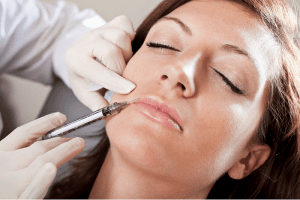As a person ages, the skin of the cheeks and lower portion of the face loses it’s elasticity. Wrinkles begin to form, and the lips lose their volume. Lips and skin can regain that volume by injecting dermal fillers. Dermal fillers are components that are injected directly into the skin to address these ageing issues. There are several types of dermal fillers. Some are comprised of human or animal tissue, while others are made of a synthetic material. Dermal fillers can either be temporary, permanent, or semi-permanent.
Depending on the situation, one dermal filler might be better than another. Temporary hyaluronic acid fillers are the most popular variety of dermal fillers. This type has been proven to be safe and efficient. The skin naturally contains hyaluronic acid, but in a matter of days it’s broken down by the body and is replaced. Temporary hyaluronic acid fillers are made so these particular molecules are better balanced in order to slow down the rate that they break down. The results of using a temporary hyaluronic acid filler can last anywhere from a couple of months to up to two years, depending on how the filler is applied. There’s no need to worry about improper placement of the product or lumpiness. A component called hyaluronidase is able to dissolve the temporary hyaluronic acid filler.
In Australia, a few brands of this type of dermal filler are Restylane, Jevederm, and Esthelis. These products come in various sized syringes. While some products merge with surrounding tissue when they’re injected, others will stay exactly where they’re placed. Because of this, certain products will work better on one spot of the face than they will on another spot.
The product Esthelis, for example, is soft and is able to be injected near the surface of the skin to clear up superficial wrinkles. Products that are thicker can cause over-correction or lumpiness. A thicker product like Jevederm Ultra Plus is useful in treating nasolabial lines as well as the marionette area of the face. Cheek augmentations can be achieved through using Juvederm Voluma, which is an even thicker substance than Juvederm Ultra Plus. Products that are thicker have a tendency to last longer than those that aren’t as thick.
As a person ages, it’s normal to change dermal filler products to best suit the needs of the patient. It’s always best to consult a doctor before using any type of filler product.

 differences among them are how long they take, what they are made of, and how they work.
differences among them are how long they take, what they are made of, and how they work.








